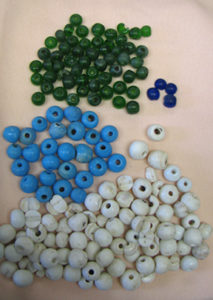
Photo Courtesy of Victoria Evans. Approximately 18,000 beads were found alongside the remains of Urraca Man, a trader who died in the late 1800s.
LAS VEGAS, NM – A New Mexico Highlands researcher will lecture April 21 on her work with a set of human remains found on the Urraca Mesa outside of Cimarron, New Mexico. Victoria Evans’ lecture will be at 11 a.m. at the City of Las Vegas Museum and Rough Rider Memorial at 727 Grand Ave.
“It piqued my interest because it was a fairly complete skeleton with a number of artifacts,” said Evans, who has been studying the remains of Urraca Man along with Highlands professor Warren Lail and their former graduate student Aaron Roth, who graduated in 2013.
A Boy Scout found the remains in the 1970s, approximately 80 years after Urraca Man is believed to have died. The remains sat in a box at a museum for a number of years before they were given to Highlands for analysis.
“We didn’t know what we had at the time,” Evans said. “I pulled out a plastic bag and thought it was full of sand. It was beads.”
At first the trio thought it could have been a Native American burial, but the evidence soon pointed the researchers to a different conclusion.
“Aaron discovered it was a male between 50 and 60 years old, of Caucasian and African descent.”
Evans said she shared the artifacts found alongside Urraca Man and shared them with other researchers including historic archaeologists and Native American Graves Protection and Repatriation Act specialists. The general consensus was that Urraca Man was not a burial.
“The tools and beads strongly suggested Urraca Man was a trader,” Evans said. “You probably wouldn’t find the quality of tools he had in a burial,” Evans said one artifact that was missing, however, was a gun.
“Cimarron was a very wild and dangerous place at the time,” Evans said. “No one would be in that area without a gun.”
Evans said the lack of a gun on the site led the three researchers to conclude Urraca Man probably had a horse or mule, which wandered off after the Urraca man slipped and died.
Evans said the trio believes Urraca Man was on the mesa trying to avoid gunslingers or trying to find a shortcut.
“Vick’s done a great job with all the artifacts,” Lail said. “She literally had to count and sort 18,000 beads. They’re tiny. You can put 5000 in the palm of your hand.
“He had some material, copper and Italian beads, that we would like to know where it came from,” Lail said.
Lail said research like this is important because researchers don’t know much about lives of traders during that time, especially ones of color.
“What interests me are those connections you make,” Evans said. “People were very connected through trade and through ideas.”
The three are working on a book on their research, which will be published by the University of Utah Press.
